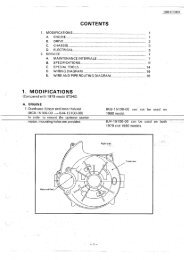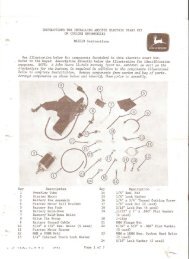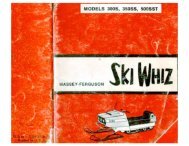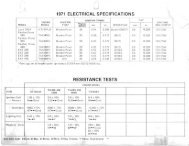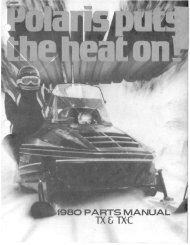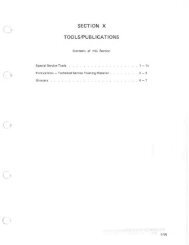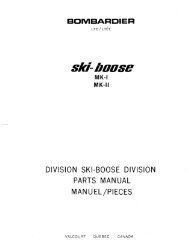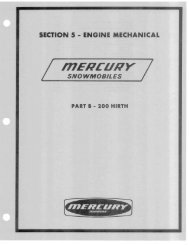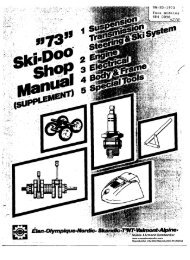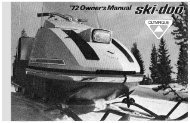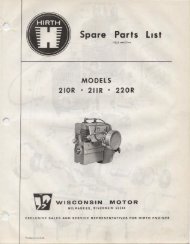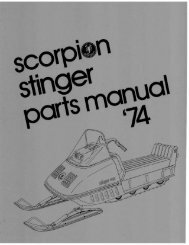1970 CCW 340 Service Manual - Vintage Snow
1970 CCW 340 Service Manual - Vintage Snow
1970 CCW 340 Service Manual - Vintage Snow
- No tags were found...
You also want an ePaper? Increase the reach of your titles
YUMPU automatically turns print PDFs into web optimized ePapers that Google loves.
carburetor inlet port, fuel/air mixture, metered by thecarburetor, is admitted to the crankcase.b. Continued upward movement of the piston will compressthe charge in the combustion chamber until, at a pointnear T.D.C., the spark from the spark plug will ignite themixture.c. Resultant expansion of the ignited fuel will push thepiston toward· B.D.C. Moving downward, the piston firstuncovers the exhaust port and allows the hot gases, stillunder considerable pressure, to escape to atmospherethrough the exhaust system.d. Continuing downward, the piston will now uncover thetwo transfer ports and close the carburetor inlet port. Themixture in the crankcase and lower part of the cylinder isdisplaced by the piston and conducted through thetransfer ducts to the combustion chamber above thepiston. The fresh charge, entering through the twotransfer ports will form a loop (see Figure 2-10), thusscavenging the cylinder of burned gases.e. The cycle will repeat continuously as from paragraph (a)until the engine ignition is switched off.2.3 IGNITION SYSTEM2.3.1 GeneralThe ignition system used with model <strong>CCW</strong> <strong>340</strong> and <strong>CCW</strong> 400engines is basically the same as systems used with mostconventio nal two stroke engines. It consists of a low tensionmagneto, two high tension ignition coils, two ignition sparkplugs, spark plug (high tension) lead wires, an ignition switchand the required electrical wiring.Modei<strong>340</strong>S engines differ from <strong>340</strong>E, <strong>340</strong>G, and 400 enginesin magneto design. Magnetos in use on the model <strong>340</strong>Sincorporate only one low tension generating coil. All othermodels covered in this manual use two low tension generatingcoils. Refer to paragraphs 2.4.2.1 and 2.4.2.2.2.3.2 DescriptionThe magneto assembly is mounted to the engine crankcase atthe flywheel end. It functions to generate low tensionimpulses in the primaries of the ignition coils. Two sets ofcontact breaker points, one set for each cyl inder, are installedin the magneto. 0 uring engine operation, a cam, mounted onthe flywheel, opens and closes the breaker points in sequence.A condenser, wired in parallel across each set of breakerpoints, protects the points from damage caused by selfinductedelectrical surges in the primary coil. Lighting andbattery charging coils (see paragraph 2.5) are mounted on themagneto coil plate. The coils produce the electrical powerrequired to operate a 12-volt lighting system and to chargethe battery used with electric started engines.Low tension (primary wires) leading from the magneto areencased in a protective cover and routed through a grommetlocated in the fan cover case, to the ignition coupler on thefan cover.2.3.2.1 Sawafuji Ignition (See Figure 2-2)The magneto used with model <strong>340</strong>S (SAWAFUJI) ignitionsystems has one low tension generating coil. Each end ofthecoil is connected in parallel to the primary of one ignition coiland one breaker point set. The condensers and breaker point2-2sets are grounded to the magneto frame through a commonground.2.3.2.2 Kokusan Ignition (See Figure 2-3)The magneto used with model <strong>340</strong>E, <strong>340</strong>G and 400( KO KUSAN) ignition systems has two low tension generatingcoils. One end of each coil is grounded to the magneto frame.The other end of the coil connects in parallel to the breakerpoint set and the primary of one ignition coil.2.3.3 Operation (See Figures 2-2 and 2-3)The ignition switch is connected in parallel with the primarywindings of the ignition coils. Operation of the ignitionswitch to the "RUN" position, opens a circuit between thewindings and allows the contact breaker points to control theignition circuit.The flywheel incorporates four permanent magnets and abreaker point cam and auto advance mechanism. In operation,as the flywheel rotates, an electrical current is generatedin the low tension generating coil. The rotating breaker pointcam activates the breaker points, opening and closing them inaccordance with a timed ignition sequence. (Refer to SectionV, paragraph 5.4.4). Closing the points causes the buildup ofa magnetic field in the ignition coils. Opening the pointscauses a very rapid collapse of the field, thus inducing a highvoltage current in the secondary windings of the coil. Hightension spark plug wires conduct the high voltage current tothe spark plugs.Self induced high voltage current in the primaries is momentarilystored in the condensers to prevent arcing across thepoint contacts. When the contacts next close, the condenserswill discharge back to the ignition coils, thus assisting in thebuildup of the magnetic field in the coils.The ignition circuit will continue to function until theignition switch is turned to the "0 FF" position which willmaintain a circuit and prevent ignition.2.4 DETONATION:-The internal combustion engine is designed to induce acombustable mixture of gasoline and air into the cylinderwhich is subsequently ignited by a spark plug, and theresultant gas expansion utilized to produce the power stroke.Some considerable care is taken in the design to ensure thatthe combustion takes place at a controlled rate, but undercertain conditions the charge will burn at a highly excessivE)rate, producing abnormal gas temperatures and pressures inthe cylinder. This condition is called detonation and may,therefore, be defined as the rapid and uncontrolled burningof the chargewh ich commences at the point of ignition by thespark plug and is completed prematurely over a very shortmovement of the piston.2.4.1 The causes of detonation are many and varied, but allhave the common effect of overheating the charge towardsthe spontaneous combustion temperature of the fuel. Consequently,when the charge is further heated by compressionand ignited by the spark, the flame spread rate is very rapidindeed, resulting in the formation of the high pressure wavewhich impinges on the combustion chamber surfaces tocreate the sound of detonation of "pinging" which is sofamiliar to many people.2.4.2 It cannot be emphasized too strongly that if detonationis allowed to persist, serious damage may result to theJ



